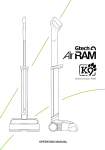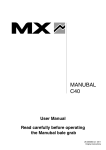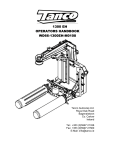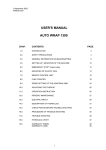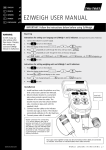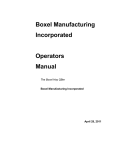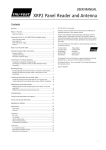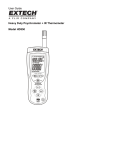Download Tru-Test Ezi Weigh 5
Transcript
This quickstart guide provides basic instructions for installing and using your EziWeigh5 indicator. Before you start Charging the internal battery Note: Before using the indicator, ensure that the internal battery is fully charged. Note: The battery indicator may not be entirely accurate when the indicator is being used in very cold conditions (below 5 ºC / 40 ºF). FCC and ICES-003 Compliance This equipment has been tested and found to comply with the limits for a Class B digital device, pursuant to part 15 of the FCC Rules. These limits are designed to provide reasonable protection against harmful interference in a residential installation. This equipment generates, uses and can radiate radio frequency energy and, if not installed and used in accordance with the instructions, may cause harmful interference to radio communications. However, there is no guarantee that interference will not occur in a particular installation. If this equipment does cause harmful interference to radio or television reception, which can be determined by turning the equipment off and on, the user is encouraged to try to correct the interference by one or more of the following measures: - Reorient or relocate the receiving antenna. - Increase the separation between the equipment and receiver. - Connect the equipment into an outlet on a circuit different from that to which the receiver is connected. - Consult the dealer or an experienced radio/ TV technician for help. This Class B digital apparatus complies with Canadian ICES-003. 816756 issue 2, 09/2011 © Tru-Test Limited, 2011 All rights reserved. Installation Note: Mount the indicator and secure the cables so they cannot be damaged by stock. 1 2 3 Install load bars under the platform on a firm, level surface (see Load Bar User Manual). Mount the indicator bracket onto a flat surface (timber rails, concrete) or pipe-work. Remove the dust caps on the load bar connectors. Connect the load bar cables to the indicator. The indicator automatically calibrates with Tru-Test load bars. 4 If required, connect the indicator to the mains power using the power/communication cable and the power adaptor. Tip: Connect the dust caps together to keep out dirt and moisture. Dust caps should remain in place at all times when the indicator is not in use. Parts of the indicator Weighing animals 1 2 3 4 Press to turn on the indicator. Move the animal onto the platform. Note the animal’s ID and weight. Wait for the stable light to illuminate. When the animal moves off the platform, the indicator automatically returns to zero. Tip: Ensure that the underside of the platform or crate is kept clear of dirt and stones. Zeroing the scale manually By default, the scale automatically zeroes itself when a load is removed from the weighing platform or when the indicator first powers up. Occasionally, you may need to use the manual zero to force the scale to return to zero, for example if there is a build-up of dirt or stones on the platform. To zero the scale manually: Press . The scale displays zero. Modifying the indicator settings There are several settings which may be customised to suit the weighing application or the environmental conditions. To view an indicator setting, press Auto Zero = screen. , Resolution = or Backlight = . The current setting is displayed on the weighing display To modify an indicator setting, press the required button repeatedly to scroll through the options. Once the desired option is displayed, wait momentarily for the indicator to return to the weighing display. Disabling auto zero By default, the scale automatically zeroes when a load is removed from the weighing platform or when the indicator first powers up. You may want to disable auto-zeroing, for example: if you are weighing a number of items together and it might take a while to load the items on the scale (e.g. weighing wool bales). In this case, the indicator may turn off after a period of inactivity and when powered up again, you would want the indicator to display the weight of the load – not zero. if you are weighing small weights on the platform. With auto zero disabled, you can use to manually zero the scale when required. To disable Auto Zero: Press until ‘Off’ displays on the screen. Modifying the resolution You can specify the minimum weighing resolution. You may want to change the minimum resolution, for example, if you are weighing very heavy loads and you are not too concerned with accuracy. By setting the resolution to 5 kg, the indicator will weigh to the nearest 5 kg and arrive at a weight more quickly. If you are weighing light loads, for example small animals, you may require more accurate measurements. By setting the resolution to 0.1 kg, the indicator will weigh to the nearest tenth of a kilogram, although it may take longer for the scale to stabilise. The resolution options depend on the type of load bars being used with the indicator. To modify the resolution: Press repeatedly to set the resolution. Adjusting the backlight You can adjust the backlight to suit the lighting conditions. Use of the backlight will affect battery consumption – the run-time will double if the backlight is set to Low instead of High. To modify the backlight setting: Press repeatedly to set the backlight to High, Off or Low. Upgrading the software The latest version of software can be downloaded from www.tru-test.com. Instructions for upgrading are provided with the download. Caring for the indicator Do not leave the indicator or load bars in water. Store the indicator in a cool, dry place. By default, the indicator turns itself off after 15 minutes of inactivity in order to conserve the battery. Wipe the indicator using a damp cloth, warm water and soap. Other cleaners may damage the case. Service and warranty information For service and warranty information, see www.tru-test.com. Specifications Total capacity 2000 or 3000 kg (4400 or 6600 lb) depending on load bars used. Resolution Set to 0.5 kg (fine mode 0.1 kg) or 1 lb (fine mode 0.2 lb). Accuracy ±1 % or 2 resolutions (whichever is greater) with Tru-Test load bars connected. Power supply 5 V DC (power adaptor). Operating temperature -10 to +40 °C (+14 to +104 °F). Storage temperature -20 to +35 °C (-4 to +95 °F). Internal battery run time Up to 20 hours with 2 load bars connected. Environmental IP67 (immersion in up to 1 m (3’) of water).





